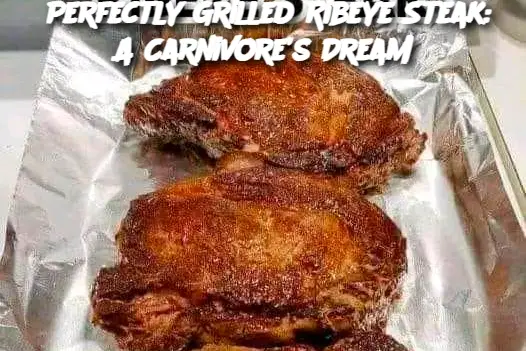For Grilling: Place the ribeye on the grill and cook for 4-5 minutes on one side to form a nice sear. Flip the steak and cook for another 3-5 minutes for medium-rare, or longer if you prefer your steak more done. For thicker cuts, consider closing the grill lid to cook more evenly.
For Pan-Searing: Place the steak in the hot pan and cook for 4-5 minutes per side for medium-rare. Add the garlic and herbs to the pan for added flavor. In the last minute of cooking, add a tablespoon of butter and spoon it over the steak for richness.
Check for doneness: Use a meat thermometer to check the internal temperature of the steak:
120-125°F for rare
130-135°F for medium-rare
140-145°F for medium
150-155°F for medium-well
160°F and above for well-done
Rest the steak: Once the ribeye reaches your desired doneness, remove it from the heat and let it rest on a cutting board for 5-10 minutes. This allows the juices to redistribute, ensuring a moist and flavorful steak.
Serve: Slice the ribeye against the grain and serve it with your favorite sides, such as mashed potatoes, roasted vegetables, or a fresh salad.
Tips for Serving and Storing:
Serving suggestions: Ribeye steak pairs beautifully with a simple side of roasted potatoes, grilled vegetables, or a creamy mushroom sauce. A side of crispy fries or a fresh Caesar salad also makes for a great complement.
Resting time: Always allow your steak to rest after cooking. This step is crucial for ensuring the juices stay locked in, making for a tender and flavorful bite.
Storing leftovers: If you have any leftover steak, store it in an airtight container in the refrigerator for up to 3 days. Reheat gently in a skillet over low heat or in the microwave to prevent the steak from drying out. Leftover ribeye also works well in sandwiches or salads.
Variants:
Garlic and Herb Ribeye: Before cooking, rub the steak with a mixture of minced garlic, fresh rosemary, thyme, and a touch of olive oil. This adds a fragrant, herby flavor to the steak.
Cajun Ribeye: For a spicier twist, season your ribeye with a Cajun seasoning blend before grilling or pan-searing. The bold flavors will add a punch to your steak.
Reverse Sear Ribeye: If you prefer to cook your ribeye in the oven, try the reverse sear method. Slow-roast the steak at 250°F until it reaches your desired internal temperature, then sear it in a hot pan for 1-2 minutes per side to achieve a crispy crust.
FAQ:
What is the best cut of beef for ribeye steak?
Ribeye steak itself is the best cut for this recipe. It’s known for its rich marbling, which makes it flavorful and juicy. However, you can also use boneless ribeye if you prefer less fat.
Should I cook ribeye steak with the bone-in or boneless?
Both bone-in and boneless ribeye steaks are delicious. The bone-in version often provides more flavor and a juicier steak, while boneless ribeye offers easier carving and faster cooking.
How can I avoid overcooking my ribeye steak?
Use a meat thermometer to ensure accurate doneness. Ribeye is best enjoyed medium-rare to medium, so keep an eye on the temperature and remove it from the heat when it reaches your target.
Can I marinate ribeye steak?
While ribeye is naturally tender and flavorful, you can marinate it for a few hours if you want to infuse additional flavors. A simple marinade with olive oil, garlic, herbs, and a bit of acid (like lemon juice or vinegar) will complement the steak without overpowering its natural taste.
What if I don’t have a grill?
If you don’t have a grill, you can easily cook ribeye steak in a cast-iron skillet or on a stovetop grill pan. Follow the same instructions for searing and cooking to achieve that perfect char and tenderness.
Enjoy your perfectly grilled or seared ribeye steak—juicy, tender, and packed with bold flavors!
ADVERTISEMENT

